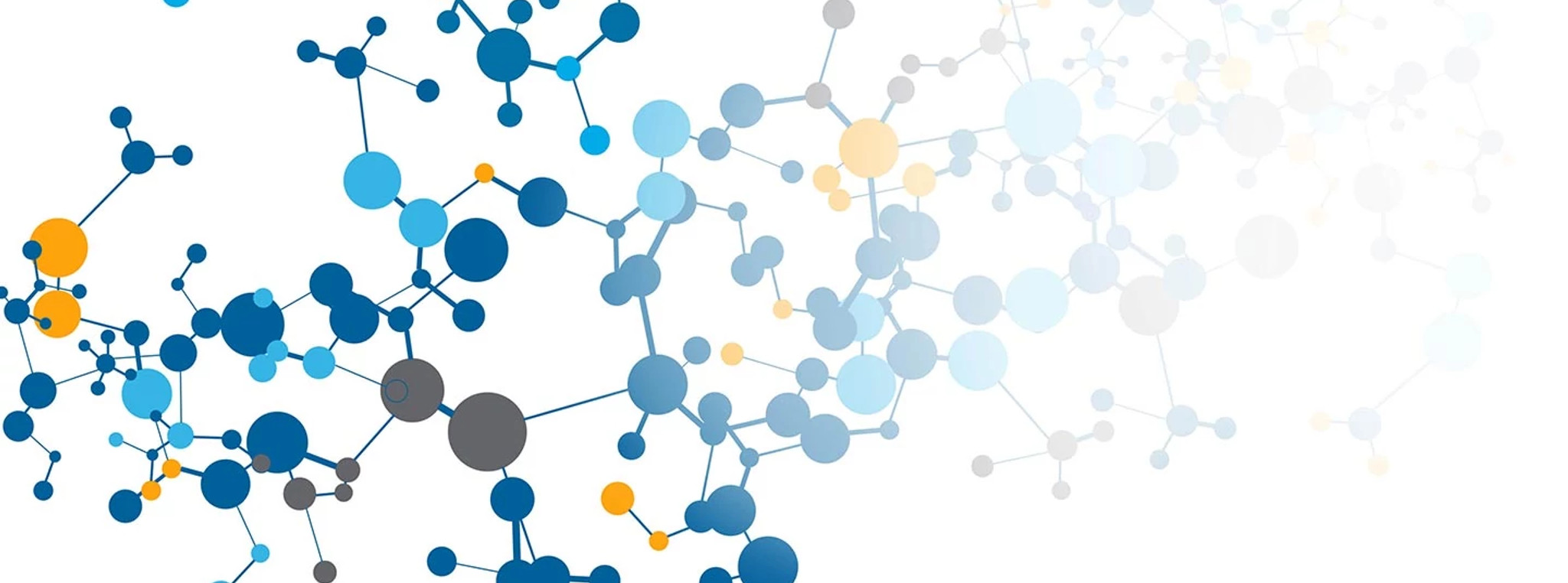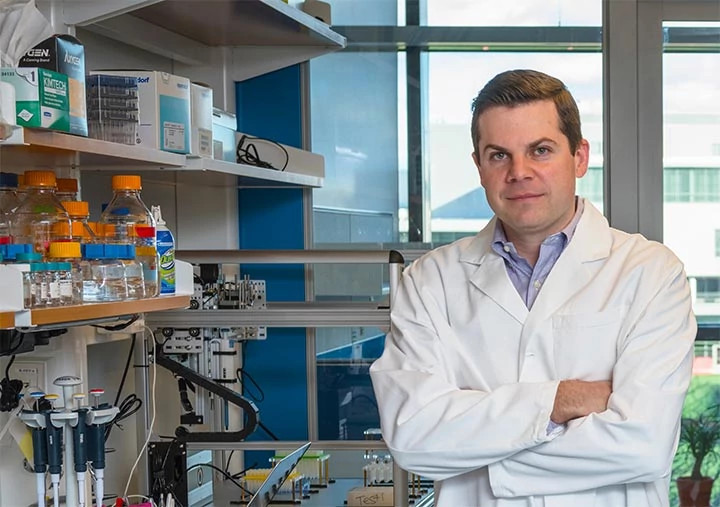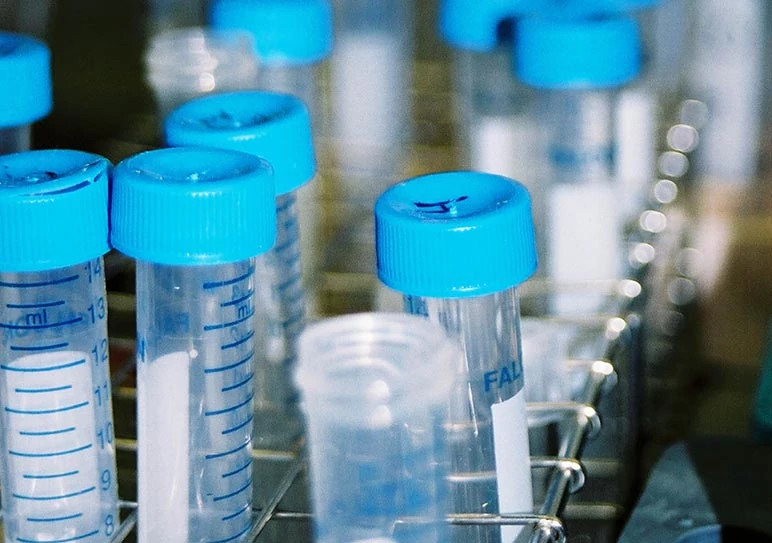
Pioneering a New Class of Cancer Drugs Designed to Make Tumor-Promoting Proteins Disappear
April 30, 2021
Protein Degradation
Chemical Biology
Nathanael Gray
Blood Cancer
By Nicole Davis, PhD

In the era of modern, so-called "targeted" cancer medicines, creating new drugs generally goes something like this: Design a molecular wrench that will jam the gears of tumor cells by blocking the action of a particular protein (the "target"), thereby halting tumor growth. But a new paradigm is evolving, pioneered by a cadre of researchers at Dana-Farber, and its guiding principle is fundamentally different. Instead of blocking the activity of cancer-promoting proteins, toss them into the cellular garbage bin and remove them altogether. It's an approach known as targeted protein degradation, and it's gaining momentum.
What makes this emerging class of cancer therapeutics so promising is not only their potential power — eliminating a protein outright can be much more profound than simply blunting its actions — but also their ability to take aim at molecules that traditional drug-making technologies have struggled to reach for decades.
There are a wide range of targets that we know to have great potential for treating cancer, but that have been largely inaccessible to drug development in the past," said Benjamin Ebert, MD, PhD, chair of Medical Oncology at Dana-Farber. "Targeted protein degradation opens up incredible opportunities for accessing those 'undruggable' targets. 
Thalidomide Goes From Infamy to Innovation
Cells routinely dispose of old or damaged proteins, breaking them down into their essential parts and reusing the components to build new proteins. Twenty years ago, researchers first proposed an idea to harness this system in a targeted way using chimeric molecules — in which fragments of two different molecules are joined together to create an entirely new one. Like a two-headed snake, one end of the chimera binds to a protein of interest and the other end to the protein-degrading machinery, thereby forcing destruction of the target.
"At the time, researchers had shown this could work in artificial systems, but not at the concentrations or with molecules that were likely to become drugs," said Nathanael Gray, PhD, a chemical biologist at Dana-Farber. "It was basically a neat trick in the realm of chemical biology."
But the field began to shift in a big way about a decade later. Two research teams, one led by Ebert and another by Dana-Farber's William Kaelin, MD, a 2019 Nobel Laureate, were studying a new blood cancer drug. Known as lenalidomide, it is a chemical cousin of thalidomide, the infamous morning sickness pill recalled in the 1960s due to the devastating birth defects it inflicted on thousands of children. With strict regulations in place, thalidomide and its relatives had been repurposed as safe and effective treatments for multiple myeloma as well as other blood cancers. Precisely how the drugs worked, however, remained unknown.
Some pivotal clues emerged when Ebert, Kaelin, and their colleagues reported in 2014 that lenalidomide targets two proteins, IKZF1 and IFZF3, for destruction. When the drug is present, these proteins are recognized by a member of the cells' protein-recycling system and flagged for degradation.
Remarkably, IKZF1 and IKZF3 are among a large group of regulatory proteins called transcription factors, which are often key drivers of tumor growth. Although these regulators are widely viewed as linchpins of modern cancer therapy, they are notoriously difficult to design drugs against. With their smooth, featureless surfaces, they are like tiny cue balls — devoid of any nooks or crannies where a drug might bind.
"When this mechanism was discovered, people began to believe that protein degradation could become a more generalized approach," said Gray. "With a successful drug already on the market, nobody could say it would never work — and that really galvanized the field."
Detailed studies of the thalidomide-like drugs are now helping to chart another critical path: how to purposefully design more transcription-factor-demolishing drugs. IKZF1 and IKZF3 contain a characteristic molecular pattern, known as a C2H2 zinc finger. It turns out that in humans, hundreds of other transcription factors harbor this same motif, too.
By carefully dissecting how the thalidomide-like drugs interact with their molecular partners (also called "substrates"), Ebert and his colleagues, along with Dana-Farber's Eric Fischer, PhD, and his team, are working out how other zinc-finger-containing transcription factors might be placed in the crosshairs of protein degraders.
"It's critically important to understand on a molecular level how these molecules recruit their substrates and why some work and some don't," said Fischer. "With this knowledge, we can use sophisticated computer modeling to help us uncover even more potential targets."
His work is not only helping spur the design of powerful new cancer drugs, but also shedding light on why the tragic outcomes wrought by thalidomide — children with severely shortened, malformed limbs as well as other birth defects — were not detected earlier during its clinical development.

Eric Fischer, PhD, leads research into new protein targets.

Nathanael Gray, PhD, co-leads the Center for Protein Degradation.
Expanding the 'Cookbook' of Protein Degradation
Thalidomide and its derivatives have blazed a trail toward harnessing protein degradation as a broad therapeutic strategy in cancer. But Dana-Farber researchers are learning there may be multiple routes to that goal.
Ebert, Fischer, and their colleagues recently studied a collection of molecular inhibitors designed to neutralize a protein called BCL6. Like IKZF1 and IKZF3, it acts as a transcription factor and plays an important role in cancer — specifically, certain types of lymphoma. Remarkably, the scientists found that one of the anti-BCL6 molecules, called BI-3802, caused the protein not to malfunction, but to disappear.
"It's a pretty amazing result, you add this molecule and BCL6 just goes away, while essentially all of the other proteins remain changed," said Ebert. "It's incredibly selective — and targets an important protein that we were never able to access before."
But the protein's path to demise is also unusual. Instead of flagging BCL6 for degradation, BI-3802 causes BCL6 to stick to itself, fashioning a continuous thread of individual proteins joined together. Such polymers are highly unusual, so cells quickly identify them. As a result, the BCL6-beaded strings are tagged for recycling and degraded.
In addition to its central role in driving some cancers, BCL6 has another noteworthy feature — like IKZF1 and IKZF3, its molecular structure sports a distinctive pattern. This one, known as a BTB domain, is also shared across multiple different proteins.
"Just as with thalidomide, if we understand in detail how the degradation of BCL6 happens, we can enable new classes of small molecules that act as protein degraders," said Fischer. "In this way, we are constantly expanding the cookbook of protein degradation."

Creating Protein Slayers in the Lab
In the past, accidental discoveries have helped drive the field of targeted protein degradation. Now, a top priority for the Dana-Farber team is figuring out how to intentionally design protein degraders against novel targets, rather than unearthing them by chance. That is an ambitious endeavor — one that involves creating an entirely new framework for discovering drugs as well as a new Dana-Farber center dedicated to propelling protein slayers toward the clinic.
"A conventional drug is all about binding, how sticky you make it. But a degrader is more of a matchmaker — its job is to get the two parties in the right position and then get out of the way," said Gray. "So, you have to reinvent the way you screen for and develop molecules that do that."
One approach draws inspiration from those early molecular chimeras — the miniature double-headed snakes that helped launch the field. To build such bi-functional molecules, the scientists must tinker with and join two types of components: molecules already proven to interact with the target protein of interest and molecules that recruit the protein degrading machinery. By making a variety of pairwise combinations and testing their destructive power, the team can glean which molecular duos are the most effective degraders.
Fischer's and Gray's laboratories, together with a group at Korea University led by Taebo Sim, PhD, recently completed such an undertaking, focusing on an important class of proteins, called kinases, which play crucial roles in controlling tumor growth. While crafting drugs against kinases is generally an easier feat than drugging transcription factors — in part because they have grooves on their surfaces where a drug can readily bind — these proteins can often outsmart conventional medicines. Targeted degradation offers a promising workaround.
The research team wanted to figure out what it would take to degrade any kinase in human cells — there are roughly 200 human kinases in total. Their vast data set, which is made publicly available online, helps demystify some of the design principles for kinase degraders and lays the foundation for a new generation of cancer drugs.
"What's most exciting about this field is the prospect of expanding the druggable space," said Fischer. "That's remarkable not only from the standpoint of scientific discovery but also, importantly, for profoundly impacting patients in the years to come."
The researchers acknowledge that the unique community at Dana-Farber is crucial for driving their work forward. Projects focused on targeted protein degradation require a broad range of scientific expertise, from genetic screens and molecular biology, to biochemistry and structural biology.
"It's impossible for any single lab to have the breadth of skills needed," said Ebert. "So, the only way to really move the needle, for science and for patients, is through collaboration."
Thalidomide Studies Offer Another Cautionary Tale
Eric Fischer, PhD, and his team have toiled for years to figure out how thalidomide and its chemical cousins work in cells. Along the way, they helped solve a longstanding mystery of how, at a molecular level, thalidomide causes birth defects.
In blood cells, thalidomide recognizes two proteins, IKZF1 and IKZF3, and targets them for demolition. But what about other tissues, like those that are destined to form limbs?
Fischer and his team discovered that those cells contain a related transcription factor called SALL4, which, like IKZF1 and IKZF3, is part of the zinc-finger family. Importantly, SALL4 is required for normal limb development. And in the presence of thalidomide, it, like its relatives, is marked for destruction.
While thalidomide underwent extensive pre-clinical testing — in animal models, including mice — no signs of birth defects were uncovered. It turns out that slight genetic differences in SALL4 in certain animals, such as mice and fish, make the protein indifferent to the drug's effects. But in other organisms, including humans, primates, and rabbits, SALL4 is vulnerable to thalidomide-induced degradation.
"One of the big challenges for the field will be how to really prove your degrader is safe when there can be these big species differences and also massive differences in degradation between different tissues and organs," said Nathanael Gray, PhD.
Dr. Benjamin Ebert Receives Sjöberg Prize 2021
Dana-Farber's Benjamin Ebert, MD, PhD, was awarded the Sjöberg Prize in 2021 for his discovery of the mode of action of lenalidomide in the treatment of haematological disorders.